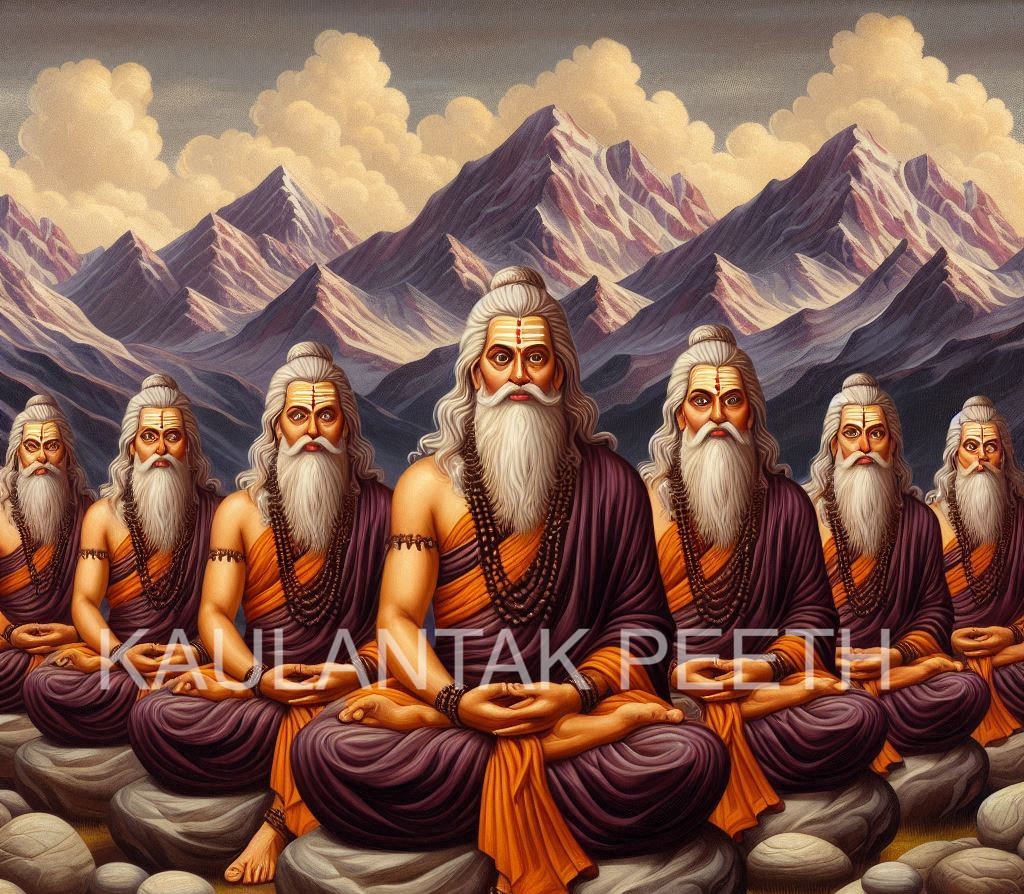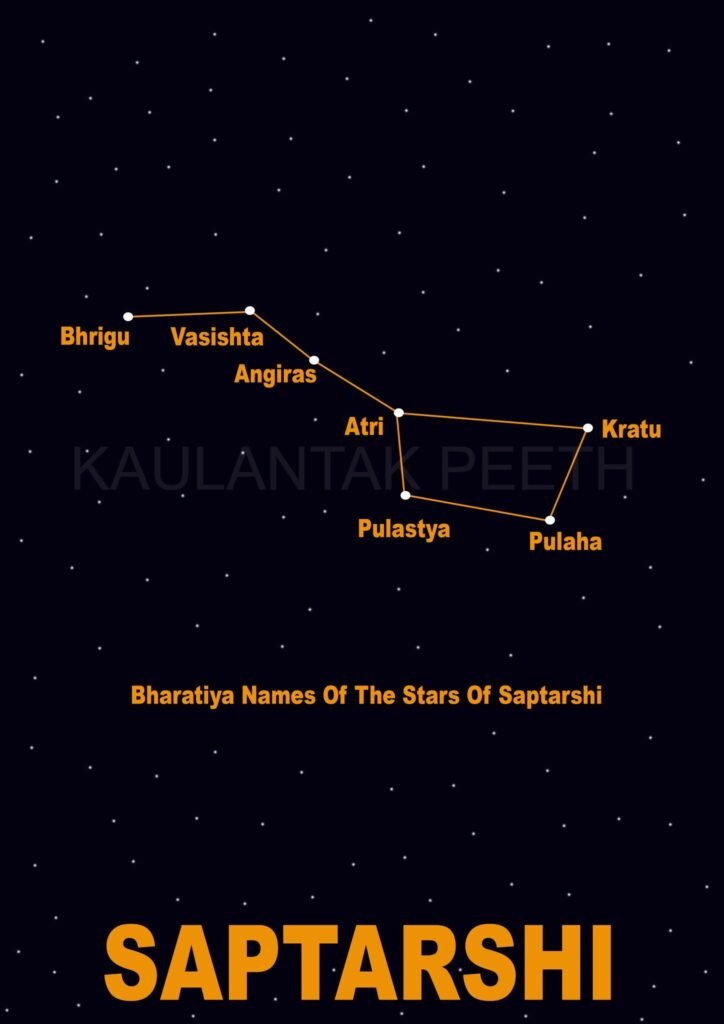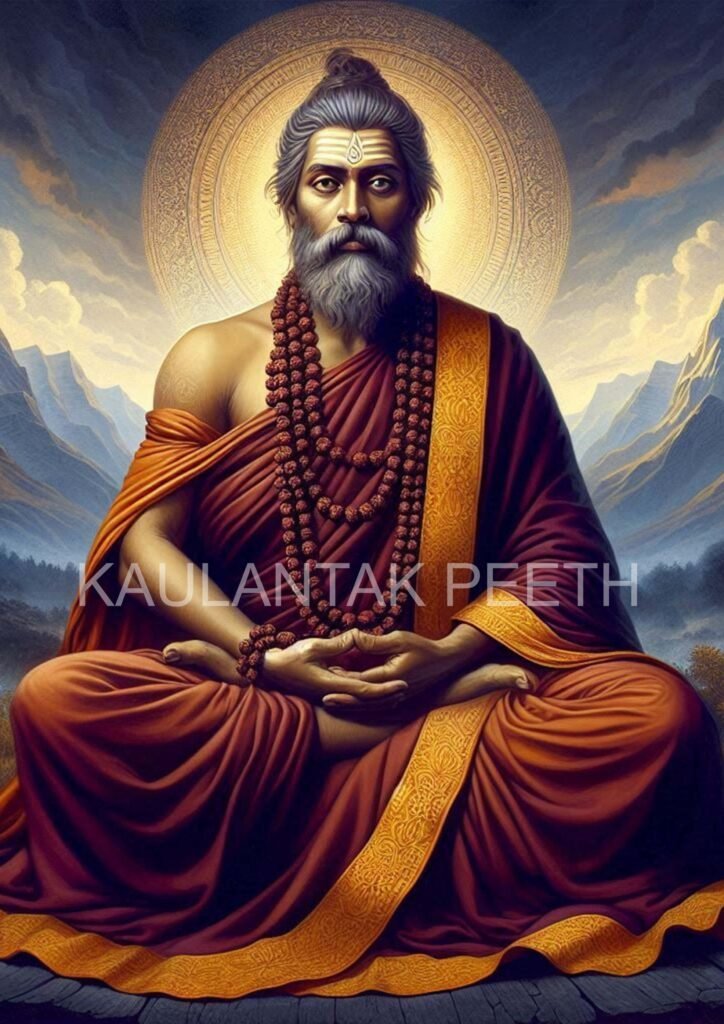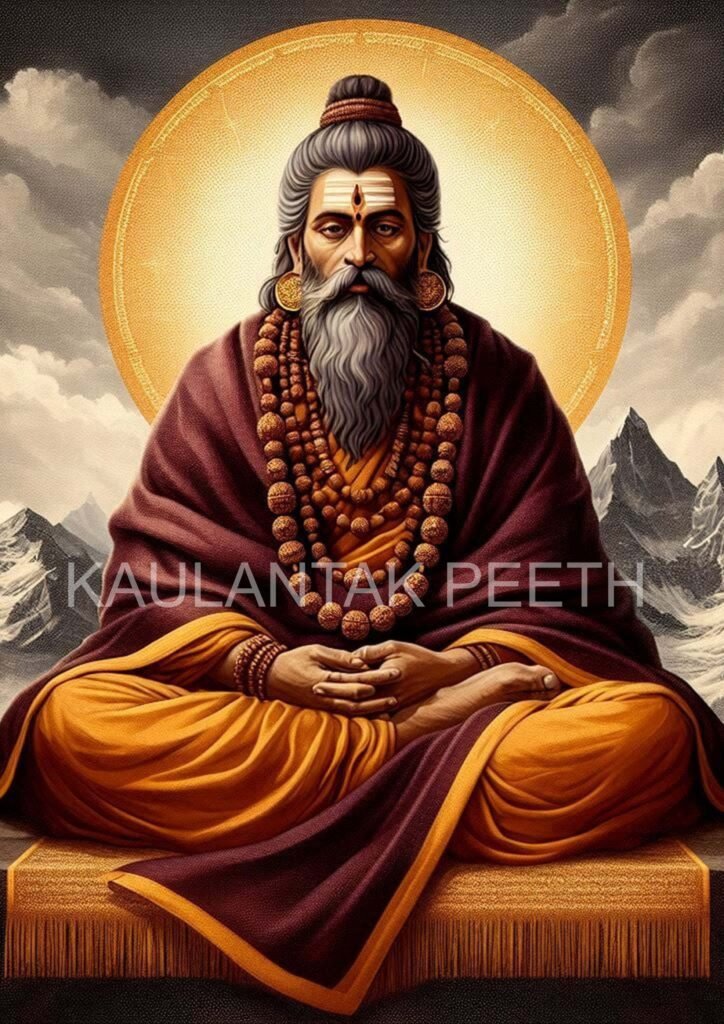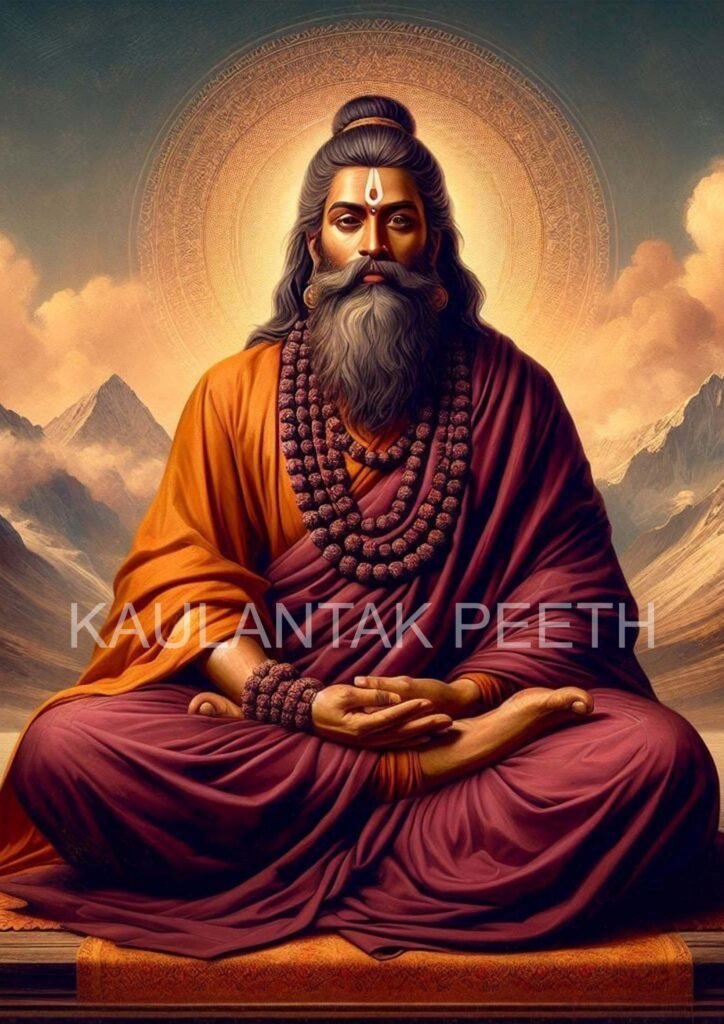The term “Saptarshi” (सप्तऋषि, “saptaṛṣi”) means “seven sages,” derived from “sapt” (सप्त, “sapta”) (seven) and “rishis” (ऋषि, “ṛṣi”) (sages). These revered figures hold a significant place in Hindu Dharma and are associated with the Big Dipper constellation in the Akash Mandala (आकाश मण्डल, “ākāśa maṇḍala”) illuminating humanity with their light. Meditators often focus on the Big Dipper constellation within the Akash Mandala during their meditation.
In Siddha Dharma traditions, the identities of the Saptarishis change with each manvantara (मन्वन्तर, “manvantara”), a specific period within Hindu cosmology, each ruled by a different Manu (मनु, “manu”). This results in varying names of the Saptarishis in scriptures like the Vedas (वेद, “veda”) and Puranas (पुराण, “purāṇa”), depending on the manvantara.
The Saptarishis are entrusted with establishing Dharma (धर्म, “dharma”) and are key transmitters of divine knowledge. They preserve eternal truths and guide humanity towards righteousness, forming the foundation of many spiritual and philosophical systems in Indian tradition.
In Vedic traditions, they are portrayed as Vedic rishis, while the Siddha Tradition believes that these Saptarishis are the founding fathers of the seven main streams of knowledge and are also perfected beings in all Kalas (कला, “kalā”). They are also part of Parmaugh GuruMandala (परमौघ गुरु मण्डल, “paramaugh guru maṇḍala”) in the Himalayan Siddha tradition. When seekers begin their learning in the Himalayan Siddha tradition, they worship the Saptarishis by erecting seven stone pillars depicting them. According to Mahasiddha Ishaputra, the Saptarishis are believed to have bestowed the Sapt Mool Kram Karmkaand (सप्त मूल क्रम कर्मकाण्ड, “sapta mūla krama karmakāṇḍa”).
Saptarishis: The Kalpa Gurus
The Saptarishis, known as the Seven Great Sages in Hindu Dharma, are revered as the manas putras of Brahma (ब्रह्मा, “brahmā”), the creator deity. Their role is pivotal as they serve as spiritual guides (Gurus) during the span of a Kalpa (कल्प, “kalpa”), which constitutes a day in the life of Brahma. According to belief, Brahma appoints these sages based on their spiritual wisdom and qualifications.
In the context of Siddha Dharma, it is understood that these seven sages remain constant across each Manvantara, which is an era within a Kalpa. A Kalpa is a vast cosmic cycle, and it consists of fourteen Manvantaras, each presided over by a different Manu. Currently, we are in the seventh Manvantara, under the rule of Vaivasvata Manu (वैवस्वत मनु, “vaivasvata manu”).
Throughout the cycles of Manvantaras, the Saptarishis remain constant but are said to take on different incarnations to uphold righteousness (Dharma) and guide humanity in spiritual knowledge. Their consistent presence across cosmic ages underscores their significance in maintaining cosmic order and spiritual harmony.
Saptarishis in each manvantara of the current kalpa (Śveta-Vārāha Kalpa)
| SL No. | Manu (manvantara) | Saptarishis |
|---|---|---|
| 1 | Svayambhuva | Atri (अत्रि, “atri”), Angiras (अंगिरा, “aṅgirā”), Pulaha (पुलह, “pulaha”), Pulastya (पुलस्त्य, “pulastya”), Kratu (क्रतु, “kratu”), Marichi (मरीचि, “marīci”), Vashistha (वसिष्ठ, “vaśiṣṭha”). |
| 2 | Svarocisha | Urja (ऊर्जा, “ūrjā”), Stambha (स्तम्भ, “stambha”), Prana (प्राण, “prāṇa”), Vata (वात, “vāta”), Prishava (पृषव, “pṛṣava”), Niraya (निरय, “niraya”), and Parivan (परिवान, “parivāna”). |
| 3 | Uttama | Kaukundihi (कौकुन्दिहि, “kaukundihi”), Kurundi (कुरुन्दी, “kurundī”), Dalaya (दलय, “dalaya”), Sankha (शंख, “śaṅkha”), Pravahita (प्रवाहित, “pravāhita”), Mita (मित, “mita”), and Sammita (सम्मित, “sammmita”) |
| 4 | Tapasa/Tamasa | Jyotirdhama (ज्योतिर्धाम, “jyotirdhāma”), Prithu (पृथु, “pṛthu”), Kavya (काव्य, “kāvya”), Chaitra (चैत्र, “caitra”), Agni (अग्नि, “agni”), Vanaka (वनक, “vanaka”), and Pivara (पिवर, “pivara”) |
| 5 | Raivata | Hirannyaroma (हिरण्यरोम, “hiraṇyaroma”), Vedasrí (वेदस्री, “vedasrī”), Urdhabahu (ऊर्धबाहु, “ūrdhabāhu”), Vedabahu (वेदबाहु, “vedabāhu”), Sudhama (सुधामा, “sudhāmā”), Parjanya (पर्जन्य, “parjanya”), and Mahamuni (महामुनि, “mahāmuni”) |
| 6 | Chakshusha | Sumedha (सुमेधा, “sumedhā”), Viraja (विरज, “viraja”), Havishman (हविष्मान, “haviṣmān”), Uttar (उत्तर, “uttara”), Madhu (मधु, “madhu”), Sahishnu (सहिष्णु, “sahiṣṇu”), and Atinama (अतिनाम, “atināma”) |
| 7 | Vaivasvata (current) |
Vashishta (वसिष्ठ, “vaśiṣṭha”), Kashyapa (कश्यप, “kaśyapa”), Atri (अत्रि, “atri”), Jamadagni (जमदग्नि, “jamadagni”), Gautama (गौतम, “gautama”), Vishvamitra (विश्वामित्र, “viśvāmitra”), Bharadvaja (भरद्वाज, “bharadvāja”) |
| 8 | Savarni | Savana (सवना, “savanā”), Dyutimat (द्युतिमत्, “dyutimat”), Bhavya (भव्य, “bhavya”), Vasu (वसु, “vasu”), Medhatithi (मेधातिथि, “medhātithi”), Jyotishman (ज्योतिष्मान्, “jyotiṣmān”), and Satya (सत्य, “satya”) |
| 9 | Brahma-Savarni | Havishman (हविष्मान्, “haviṣmān”), Sukriti (सुकृति, “sukṛti”), Satya (सत्य, “satya”), Apammurtti (आपमूर्ति, “āpamūrti”), Nabhaga (नाभाग, “nābhāga”), Apratimaujas (अप्रतिमौजस्, “apratimaujas”), and Satyaketu (सत्यकेतु, “satyaketu”) |
| 10 | Dharma-Savarni | Tapaswi (तपस्वी, “tapasvī”), Sutapas (सुतपस्, “sutapas”), Tapomurti (तपोमूर्ति, “tapomūrti”), Taporati (तपोरति, “taporati”), Tapodhriti (तपोधृति, “tapodhṛti”), Tapodyuti (तपोद्युति, “tapodyuti”), and Tapodhana (तपोधन, “tapodhana”) |
| 11 | Dharma-Savarni | Nischara (निश्चर, “niścara”), Agnitejas (अग्नितेजस्, “agnitejas”), Vapushman (वपुष्मान्, “vapuṣmān”), Vishnu (विष्णु, “viṣṇu”), Aruni (अरुणि, “aruṇi”), Havishman (हविष्मान्, “haviṣmān”), and Anagha (अनघ, “anagha”) |
| 12 | Rudra-Savarni | Tapaswi (तपस्वी, “tapasvī”), Sutapas (सुतपस्, “sutapas”), Tapomurti (तपोमूर्ति, “tapomūrti”), Taporati (तपोरति, “taporati”), Tapodhriti (तपोधृति, “tapodhṛti”), Tapodyuti (तपोद्युति, “tapodyuti”), and Tapodhana (तपोधन, “tapodhana”) |
| 13 | Deva-Savarni | Nirmoha (निर्मोह, “nirmoha”), Tatwadersin (तत्वदर्शिन्, “tattvadarśin”), Nishprakampa (निष्प्रकम्प, “niṣprakampa”), Nirutsuka (निरुत्सुक, “nirutsuka”), Dhritimat (धृतिमत्, “dhṛtimat”), Avyaya (अव्यय, “avyaya”), and Sutapas (सुतपस्, “sutapas”) |
| 14 | Indra-Savarni | Agnibshu (अग्निभूष, “agnibhūṣa”), Suchi (सुचि, “suci”), Aukra (औक्र, “aukra”), Magadha (मगध, “magadha”), Gridhra (गृद्ध्र, “gṛddhra”), Yukta (युक्त, “yukta”), and Ajita (अजित, “ajita”) |
Saptrishis of Vaivasvat Manvantar
We are currently in the Kaliyuga of Vaivasvata Manvantara. The Saptarishis of this Manvantara are Atri (अत्रि, “atri”), Bharadvaja (भरद्वाज, “bharadvāja”), Gautama Maharishi (गौतम महर्षि, “gautama maharṣi”), Jamadagni (जमदग्नि, “jamadagni”), Kashyapa (कश्यप, “kaśyapa”), Vasistha (वसिष्ठ, “vaśiṣṭha”), and Vishwamitra (विश्वामित्र, “viśvāmitra”).
The Sapt Gyan Kosh (सप्त ज्ञान कोश, “sapta jñāna kośa”) teaches how a person can attain the level of the Saptarishis, explores the various sources of knowledge in the universe, and compiles the teachings of these sages into sutras. According to the Sapt Gyan Kosh, knowledge in this universe is transmitted not only through words but through various other means.
The Saptarishis have seven gunbandhas (गुणबन्ध, “guṇabandha”), manifested as seven lights, from which all Siddhas gain knowledge through meditation. These orbs, termed gunbandhas, hold knowledge. The word “guna” denotes knowledge and “bandhas” connotes that this knowledge is sealed. By meditating on these Sapt Gunbandhas, Siddhas attain seven gunas or qualities of Saptrishis.
In the tradition of Dev Sanyas (देव सन्यास, “deva sannyāsa”) or Kula Sanyas (कुल सन्यास, “kula sannyāsa”), practitioners undertake a rigorous seven-year practice known as Rishitva Siddhi (ऋषित्व सिद्धि, “ṛṣitva siddhi”). Each year is dedicated to mastering the qualities exemplified by one of the Saptarishis. This method, known as Rishitva Siddhi, is a primary form of Sadhana (साधना, “sādhanā”) (spiritual practice) at Kaulantak Peeth (कौलान्तक पीठ, “kaulāntaka pīṭha”) in Siddha Dhamra, emphasizing the embodiment and realization of the virtues upheld by the ancient sages.
Maharishi Atri
Atri Maharishi (अत्रि महर्षि, “atri maharṣi”), one of the Saptarishis, is celebrated for his immense contribution to the Rigveda (ऋग्वेद, “ṛgveda”), where his hymns are dedicated to Agni (अग्नि, “agni”), Indra (इन्द्र, “indra”), and other deities. His deep meditation and penance earned him profound wisdom, making him a revered figure in Vedic tradition. Atri’s legacy extends through his descendants, notably his son Dattatreya (दत्तात्रेय, “dattātreya”), who is considered a combined incarnation of Brahma, Vishnu (विष्णु, “viṣṇu”), and Shiva (शिव, “śiva”). Atri’s spiritual prowess is exemplified in various texts, where he is depicted as a beacon of Dharma and a guide to numerous disciples seeking enlightenment.
Maharishi Bharadvaja
Bharadvaja Maharishi (भरद्वाज महर्षि, “bharadvāja maharṣi”), esteemed for his scholarly contributions, is often associated with the codification of Vedic rituals and practices. His works, particularly in the Rigveda, reflect a profound understanding of cosmology and ritualistic traditions. Bharadvaja is also linked to Ayurveda (आयुर्वेद, “āyurveda”), with the Bharadvaja Samhita (भरद्वाज संहिता, “bharadvāja saṃhitā”) being a crucial text in the field. His teachings emphasized the integration of knowledge, discipline, and ethical conduct, making him a pivotal figure in the dissemination of Vedic wisdom. Bharadvaja’s ashram was a renowned center of learning, attracting students and scholars from far and wide.
Maharishi Gautama
Gautama Maharishi (गौतम महर्षि, “gautama maharṣi”), a pivotal figure in Hindu jurisprudence, is the author of the Gautama Dharma Sutra (गौतम धर्मसूत्र, “gautama dharmasūtra”), one of the earliest texts outlining the duties and ethical conduct prescribed by Hindu law. His hymns in the Rigveda demonstrate his spiritual depth and devotion to the divine. Gautama’s association with the Nyaya (न्याय, “nyāya”) school of philosophy, through the foundational Nyaya Sutras (न्याय सूत्र, “nyāya sūtra”), underscores his influence on logical and epistemological discourse. The legend of his wife, Ahalya (अहल्या, “ahalyā”), and her subsequent redemption by Lord Rama (राम, “rāma”), adds a layer of moral and spiritual narrative to his legacy.
Maharishi Jamadagni
Jamadagni Maharishi (जमदग्नि महर्षि, “jamadagni maharṣi”), renowned for his austere lifestyle and spiritual discipline, is also celebrated as the father of Parashurama (परशुराम, “paraśurāma”), the warrior sage and sixth avatar of Vishnu. His life is marked by his unwavering commitment to Dharma and his mastery in martial skills and sacred knowledge. Jamadagni’s intense penance and devotion to righteousness have been documented in various Puranic texts, portraying him as a sage who balanced his ascetic practices with the responsibilities of a householder. His legacy is also highlighted by the severe tests of character and virtue he imposed on himself and his family.
Maharishi Kashyapa
Kashyapa Maharishi (कश्यप महर्षि, “kaśyapa maharṣi”) is a cornerstone of Hindu cosmology, often regarded as the father of many deities, demons, and other celestial beings. His contributions span various branches of Vedic knowledge, including rituals, astronomy, and medicine. Kashyapa’s hymns and teachings emphasize the interconnectedness of all life forms and the cosmic balance maintained through adherence to Dharma. His extensive progeny, born through his union with multiple wives, symbolizes the diversity and richness of creation. Kashyapa’s wisdom is reflected in his role as a mediator and guide in the history of Sanatan Dharma (सनातन धर्म, “sanātana dharma”).
Maharishi Vasistha
Vasistha Maharishi (वसिष्ठ महर्षि, “vaśiṣṭha maharṣi”), renowned for his unparalleled wisdom and spiritual prowess, served as the royal priest of the Ikshvaku dynasty (इक्ष्वाकु वंश, “ikṣvāku vaṃśa”), including the illustrious King Dasharatha (दशरथ, “daśaratha”) and his son, Lord Rama. His teachings, encapsulated in the Yoga Vasistha (योग वसिष्ठ, “yoga vaśiṣṭha”), provide profound insights into the nature of reality, the self, and the universe. Vasistha’s role in the Ramayana, where he offers guidance and counsel to Rama, highlights his status as a preeminent sage whose wisdom transcended time and circumstance. His ashram was a sanctuary of learning and spiritual practice, attracting seekers from all walks of life.
Maharishi Vishwamitra
Vishwamitra Maharishi (विश्वामित्र महर्षि, “viśvāmitra maharṣi”)’s journey from a Kshatriya king to a Brahmarishi is one of the most inspiring tales of transformation and spiritual attainment. His relentless pursuit of knowledge and penance, often in rivalry with Vasistha, ultimately earned him the highest honor among sages. Vishwamitra is credited with creating new hymns for the Rigveda and pioneering the Gayatri Mantra (गायत्री मंत्र, “gāyatrī mantra”), a revered Vedic chant. His tutelage of Lord Rama and Lakshmana in the art of warfare and spiritual practices, as depicted in the Ramayana, underscores his multifaceted contributions to both martial and spiritual domains.
The Purpose of Saptrishi Sadhna
The goal of Saptrishi Sadhana (सप्तऋषि साधना, “saptaṛṣi sādhana”) is two-pronged: first, to acquire knowledge and cultivate a purposeful life that leads to spiritual enlightenment; second, to attain Rishitva Siddhi, the mastery of Rishi qualities, ultimately leading to Moksha (मोक्ष, “mokṣa”) or liberation. The Saptrishis teach to live a Satvik lifestyle primarily, while in some cases, they also advocate leading a Rajsik lifestyle. The Saptrishis are the pillars of Sanatan Dharma and Siddha Dharma, as well as the Agama-Nigama (आगम-निगम, “āgama-nigama”) and Tantric lineage systems. Saptrishi Sadhana bestows us with strength, intellect, knowledge, prosperity (Bal, Buddhi, Vidya, and Aishwarya) (बल, बुद्धि, विद्या, और ऐश्वर्य, “bala, buddhi, vidyā, aura aiśvarya”), along with courage and fortune.

